Rest and Relaxation Pants Fashion Report
Last year, Julia King, a 20-year-old art educatee and influencer from Texas, noticed that a detail kind of sweater belong was taking over the net. Celebrities like Bella Hadid had been photographed wearing shrunken argyle-patterned styles, channeling archetype '90s movies like Clueless during a wave of millennium-era nostalgia. Soon, King establish the perfect instance in a thrift shop: a child-sized pink and red knit vest that fit tight and cropped on an developed. Using herself as a model, King paired it with jeans and a Dior bag, snapped a picture, and listed it for $22 on Depop, an eBay-like resellers' app favored past Gen Z.
The vest sold instantly, and she apace forgot almost information technology. But a calendar month or and then after, King received a bulletin from one of her Instagram followers. They alerted her that an obscure, at present-defunct Chinese shopping site called Preguy was using her photo to sell its own cheap reproduction of the thrifted vest. "Seeing the pictures of me up on some random fast-manner website I'd never heard of before fabricated me actually upset," King said.
Replicas of the vest soon began popping upwards on countless other wear sites and due east-commerce marketplaces, including Amazon, AliExpress, Walmart, and Shein. Over time, the epitome of King's torso would be altered, warping her body shape; at one bespeak, another person'due south manicured paw was awkwardly photoshopped onto it.
Eventually, retailers began using their own product photos, but that didn't brand the feel any less surreal. Unknown brands with names like GadgetVLot and WEANIA marketed their versions of the vest with jumbled strings of keywords: "Autumn Preppy Style Streetwear Clothes," "Plaid Cotton Knitted Vest Elastic Five-neck Sweater Ingather."
A vest that had started as a 1-off austerity discover was now available for anyone to buy, and often for an even lower price. Equally with many fashion trends, it had been plucked from social media and dropped into the frenzied machine of the global e-commerce market place. It was multiplying, almost of its own accord, in the factories of China'southward swelling ultra-fast-fashion industry.
Over the past decade, thousands of Chinese article of clothing manufacturers have begun selling directly to international consumers online, bypassing retailers that traditionally sourced their products from the land. Equipped with English-linguistic communication social media profiles, Amazon seller accounts, and admission to nimble garment supply bondage, they've fueled the acceleration of trends and flooded closets everywhere with a wave of impossibly inexpensive apparel.
Residual of World spent the last six months investigating this new ecosystem, speaking with manufacturers, collecting social media and production information, making test buys, and interviewing shoppers and industry experts in both China and the U.S. Our reporting reveals how Chinese clothes makers have evolved to cater to the desires of internet-native consumers — and transformed their consumption habits in the process. Capitalizing on this shift are companies like Shein: the nigh successful, well-known, and well-funded online retailer of its kind.
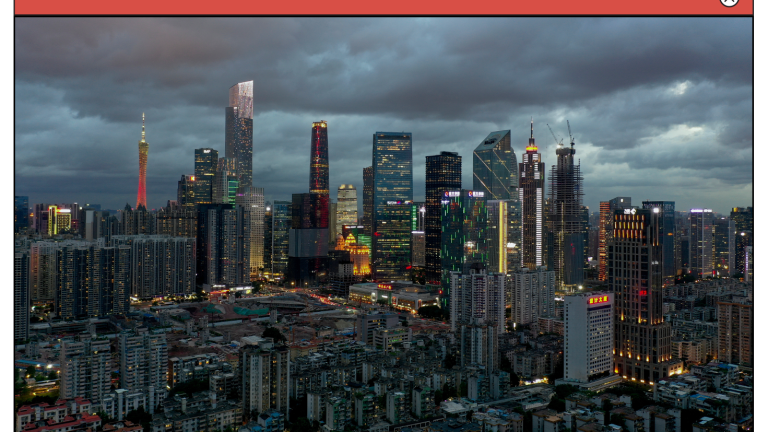
Shein is now one of the world'southward largest manner companies, but little is known about its origins.
It was founded in 2012 under the name SheInside, and reportedly began by selling wedding dresses away from its first headquarters in the Chinese city of Nanjing. (A spokesperson for Shein denied it ever sold wedding dresses, but declined to specify other details near its history.) The visitor says its founder, Chris Xu, was born in Cathay, though a since-deleted press release described him as from the U.Southward.
Shein eventually expanded to offer apparel for women, men, and children, as well equally everything from home goods to pet supplies, only its core business remains selling clothes targeted at women in their teens and 20s — a generation who grew upwardly exploring their personal fashion on platforms like Instagram and Pinterest.
Its clothes aren't intended for Chinese customers, simply are destined for export. In May, the company became the most popular shopping app in the U.S. on both Android and iOS, and, the same month, topped the iOS rankings in over 50 other countries. It'due south the second most pop fashion website worldwide.

By 2020, Shein'due south sales had risen to $10 billion, a 250% jump from the yr before, co-ordinate to Bloomberg. In June, the company accounted for 28% of all fast fashion sales in the U.S. — nigh as much as both H&M and Zara combined. The same calendar month, a report circulated that Shein was worth over $47 billion, making information technology one of the tech industry's most valuable private startups. (Shein declined to say whether the sales or valuation figures were accurate.)
Shein'due south fast growth has brought with it a series of controversies. Numerous designers accused it of stealing their work, and brands similar Levi Strauss and Dr. Martens sued the company for trademark infringement. (The former after settled for an undisclosed sum, while Shein said it doesn't comment on ongoing litigation). Information technology was also skewered for selling culturally or historically offensive products, like swastika necklaces. About notably, advancement groups and journalists accept uncovered show that Shein's $11 bikinis and $7 crop tops were beingness made by people working under brutal conditions, while environmental experts warned those same items were frequently only existence worn once before getting thrown away.
At the heart of these bug is Shein'south ambitious business model. Comparisons to fast-fashion giants like H&M miss the bespeak: information technology's more than similar Amazon, operating a sprawling online marketplace that brings together around half-dozen,000 Chinese clothing factories. It unites them with proprietary internal management software that collects near-instant feedback about which items are hits or misses, allowing Shein to guild new inventory well-nigh on demand. Designs are commissioned through the software; some original, others picked from the factories' existing products. A polished advertising operation is layered over the summit, run from Shein's head offices in Guangzhou.
Through its manufacturing partners on the ground in China, Shein churns out and tests thousands of different items simultaneously. Between July and December of 2021, it added anywhere between 2,000 and 10,000 SKUs — stock keeping units, or individual styles — to its app each twenty-four hour period, co-ordinate to data collected by Rest of World. The visitor confirmed it starts past ordering a small batch of each garment, often a few dozen pieces, and then waits to see how buyers respond. If the cropped sweater vest is a hit, Shein orders more. It calls the organisation a "large-scale automated test and re-order (LATR) model."
"Fast fashion is well-known for its very frequent replenishment of products," said Sheng Lu, a professor at the University of Delaware studying the global fabric and clothes manufacture. "But Shein is totally different." From January to October of 2021, Lu'south research found the company offered more than 20 times as many new items as Zara and H&M.
Amazon'south activity in Red china may have inadvertently contributed to Shein's success. Starting around 2013, the due east-commerce giant began aggressively recruiting manufacturers in the country to sell cheap products away on its 3rd-party marketplace. As Chinese sellers joined the platform, Western consumers were flooded with thousands of new brands selling bones appurtenances from kitchen supplies to electronics chargers under unfamiliar names like Nertpow, FRETREE, and BSTOEM.
Amazon gave these factories the enormous opportunity to cutting out Western middlemen and begin learning near the tastes of American shoppers. In turn, Amazon was able to undercut the prices of its competitors, and past 2020, 40% of its third-party sellers were based in Communist china.
But the partnership between Amazon and Chinese manufacturers eventually began to sour. Customer complaints most counterfeits and dangerous products from China were putting a dent in the tech company'south reputation, and this September, Amazon banned hundreds of Chinese merchants for allegedly using false product reviews. Many of the sellers weren't entirely happy with Amazon either, which required them to abide past an always-shifting gear up of policies and pay hefty fees for services like warehousing and order fulfillment.
"This cost is very high," said Du Tianchi, the founder of an apparel company in China's Jiangsu province that sells on Amazon and AliExpress. "In one case your Amazon storage is out of stock [in the U.South.], you take to replenish it from China, which is time-consuming."
Rising frustration with Amazon among Chinese sellers opened a window for Shein, which recruited many of them to supply its ain platform. But Shein didn't just try to compete with Amazon: it joined it. The company offers thousands of its own products on Amazon's market place, including some that take get bestsellers.
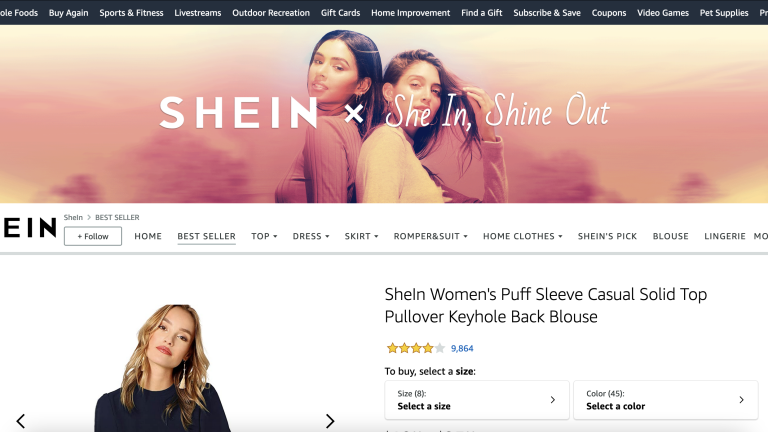
"Amazon whet the palate for online shopping, taught [Americans] how to shop online, and created the habit," said Allison Malmsten, a China market analyst at Daxue Consulting in Hong Kong. "Shein realized that and decided to optimize it."
Rather than mimicking Amazon directly, Shein grew by bringing traits of People's republic of china's gamified e-commerce market to the residuum of the globe. Online shopping in the land has evolved into a class of entertainment, featuring livestreamers, flash sales, and enticing pop-ups that compel consumers to scroll through the newest products. Taobao, a domestic Chinese e-commerce platform owned by Alibaba, helped pioneer interactive features similar custom product recommendations and fifty-fifty congenital a mini–social network into its app. Shein has used similar components on its platform, including a points system that rewards shoppers for making purchases, leaving reviews, and playing minigames.
Malmsten said that Shein has learned a lot from the strategies of Chinese e-commerce companies. "Shein brought that mode [of shopping] to the West, and it really works with Gen Z," she said.
After watching the company's rapid rise, major Chinese tech giants and newer startups are now racing to imitate it. The competition includes ByteDance and Alibaba, which are both working on eastward-commerce platforms targeting the same international demographic as Shein. Then there are brands like Cider, a Hong Kong–based due east-commerce clothing brand backed by the legendary venture uppercase firm Andreessen Horowitz. In a blog mail announcing its investment, the business firm described Cider equally a "market place of global factories that makes it possible for users to accept more selection than Zara, at the price point of Forever 21, on-demand."
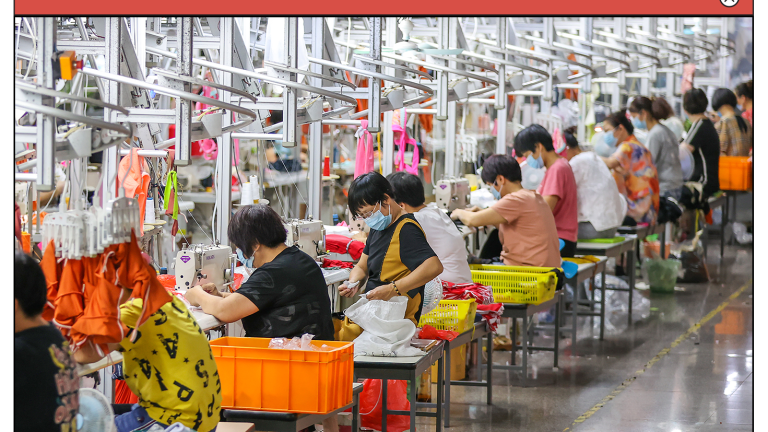
Lin Zhen is a Chinese clothing manufacturer and the caput of the largest organization of Amazon sellers in Fujian, ane of China'southward main garment-producing provinces. He has sold article of clothing to consumers in Europe and North America directly since 2011, long before they learned to purchase everything from mattresses to toothpaste on Instagram. Today, Lin'south clothing company, Xiamen Ouchengsheng, known as OCS, earns well-nigh $100 one thousand thousand in annual overseas sales, he told Rest of World. This year, near half came from Amazon, a tertiary from the company's website, and the rest came through AliExpress or selling to other businesses, including Shein.
Lin said that Shein originally approached OCS because it was one of the top sellers of dresses on AliExpress, Alibaba's east-commerce platform for markets exterior China. Lin said that the visitor mandated that he produce a certain number of different styles every month, and deliver some in as fast as 10 days. "The requirements are kind of high," he said.
Considering of the variety of styles Shein demands, suppliers that already take a range of production capabilities and function "more like factories" accept an easier time working with the company, Lin explained.
"Shein just kind of blew Zara out of the water."
Lin said he feels positive about what Shein has done for Chinese apparel sellers. The company'due south power to persevere through a number of challenges — worsening tensions between the U.S. and Prc, global supply chain slowdowns, and an ongoing pandemic — is a result of a "long-term vision" that has included "meticulous supply chain management," he told Residuum of World.
The hush-hush is Shein's internal software, which connects its entire business from blueprint to delivery. "Everything is optimized with big data," Lin said. Each of Shein'south suppliers gets their own account on the platform, which spits out data about what styles are selling well and can too quickly identify which might become future hits. "You lot tin can see the current sales, and so information technology volition tell yous to stock up more if yous sell well and what you lot demand to do if you don't sell well. Information technology'southward all at that place."
The software contains uncomplicated pattern specifications that help manufacturers execute new orders quickly. "A big brand might demand a very high-stop designer, or a designer with top technology, and fifty-fifty and then may but be able to produce 20 or 30 styles a month," said Lin. "Simply Shein does non have high design requirements. It is possible that a typical university pupil could get started designing quickly, and the output could be high."
A spokesperson for Shein declined to say much about the software, but said the company invests "heavily in training, technology, and It support to help our suppliers become more efficient and profitable."
For years, European brands like Zara and H&M have embodied fast fashion, shortening the route from runway to storefront from months to weeks. But Shein isn't chasing runway trends — rather, it oft knocks off items seen on TikTok and Instagram, where hype cycles move significantly faster. Whereas Zara typically asks manufacturers to turn around minimum orders of 2,000 items in 30 days, Shein asks for as few as 100 products in as little as 10 days. "They want factories to be much more nimble," said Lu.
That pressure level to produce wearing apparel more rapidly ends up falling on Chinese garment workers, who sew products for Shein during long shifts in poorly regulated workshops, according to reporting past the Chinese media site Sixth Tone. A knitting auto operator at a mill in the city of Zhejiang told Rest of World that, in China's garment sector, working overtime is "a certainty."
"Like all the manufacturing industries in China, the number of employees working overtime is, basically, already saturated," said the worker, who asked to remain anonymous because they weren't authorized to speak about their job publicly. "It's incommunicable to go to work from nine to five." (The factory where they piece of work doesn't supply for Shein, but does manufacture clothes for other foreign brands and for sale on AliExpress.)
In emailed comments, Shein said the company takes "all supply concatenation matters seriously and is fully committed to upholding high labor standards." It added that it takes "immediate action" if it identifies that a supplier isn't adhering to its code of carry.
Shein'due south software-driven model allows it to remain at arm'due south length from the labor force actually making the products on its platform. It tin also avoid direct managing inventory for almost any of the products it sells, minimizing the corporeality of appurtenances sitting unbought in warehouses.
To convince suppliers to join its system, Shein had to run across only a very basic bar: paying them on time. Receiving timely payments is a huge problem for factories in China, said Malmsten. "They've built a lot of loyalty from their suppliers, so they tin have more urgency on their orders," she said. The result is that over 70% of products on Shein'southward website were listed less than 3 months ago, Malmsten found, compared to 53% at Zara and 40% at H&Grand. "Shein just kind of blew Zara out of the water," she said.
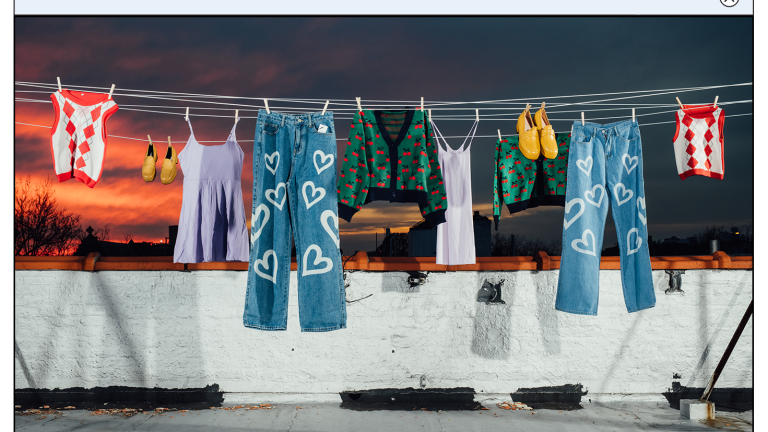
There is a downside to Shein working with and then many different factories at the aforementioned fourth dimension: like products are leaking all over the internet. Because some suppliers like Lin sell through multiple channels, consumers accept complained on social media about seeing the aforementioned wearing apparel appear on Shein, AliExpress, Amazon, and stand-alone e-commerce sites, all at different prices. The duplicated products are often brandless nuts, similar T-shirts, or otherwise knockoffs of items from independent labels and major fashion houses. Since they don't seem exclusive or unique, consumers are wary about getting duped into paying more than they should.
Communities have sprung up on TikTok, Reddit, and Facebook where shoppers share tips about how to notice identical-looking clothes for half the price or how to buy a convincing "dupe" (a copycat version) of this flavor's hottest designer handbag. Over the summertime, when a roughly $xvi criss-cantankerous crop tiptop from Amazon went viral, TikTok users began pointing out that it was available for only $xiii on Shein and as low as $3.83 on AliExpress.
"They're spending truckloads of money trying to capture consumers who are searching for products."
These forums are the natural consequence of an online shopping ecosystem that has made international consumers more enlightened of the Chinese companies making their wearing apparel. Because they know the majority of what they buy is coming from Mainland china, many people, understandably, presume that like items originated from the same factories. While that can exist the case, test buys conducted past Residue of World suggest that the environment is more complicated.
In September 2021, we ordered five vesture pieces from unlike shopping sites — Cider, Shein, and Amazon, also every bit the online brands Halara and Store-Pêche. We also bought what looked like imitations of the same products on AliExpress. Nosotros plant that, while the items were often extremely similar, most weren't carbon copies. This suggests that while some suppliers are offering the same products on multiple websites, clothes factories in China are besides extremely good at mimicking one some other and adapting to the aforementioned trends.

"Many of these companies are leveraging data to forecast what items they should produce," said Lu, from the University of Delaware. "If you use the aforementioned data inputs, and yous're using the same algorithm, maybe the result is as well very similar — if not exactly the same."
"At many of these companies these days, including, I suspect, at Shein, it'due south not the fashion guys that are designing clothing," he said. "Information technology'south engineers. Engineers looking at data."
Among the examination buys were ii sweater vests, both marketed using Julia King's Depop photograph: one from Amazon, one from AliExpress. While constructed in the same way, i was more candy apple in colour, the other a more burgundy tone. At that place were like shade differences, subtle merely noticeable, between ii cherry-print cardigans from Shein and AliExpress. Heart-print jeans from Cider and AliExpress differed in cloth and stitching. But a pair of yellow platform clogs from Shop-Pêche — a clothing make whose website says information technology was founded in New York — were indistinguishable from their AliExpress equivalent.
In an environment where the contest can rapidly copy your products, a company is ready autonomously by its marketing. Shein has poured meaning funds into Google and Facebook advertising campaigns, influencer deals, and even its ain social-media reality bear witness co-hosted by Khloe Kardashian. "They're spending truckloads of money trying to capture consumers who are searching for products," said Cooper Smith, an e-commerce and fashion manufacture analyst who previously worked as the caput of Amazon intelligence at Gartner.
Shein'south approach appears to exist paying off: In August, its website had 150 million visitors, 40% of whom came via search, according to Similarweb, compared to iv% of Zara's. On social media, the company has partnered with countless micro-celebrities, manner bloggers, and contestants from reality shows similar The Available, who prove off deliveries of trendy clothes in "haul" videos posted to TikTok and Instagram. Before Shein's app was banned by the Indian government last year, the company was at once reportedly working with roughly two,000 influencers in the country alone.
"They've been actually smart in understanding their Gen Z customers and the types of content that they resonate with," said Emily Trenouth, caput of influencer marketing at the agency MediaCom.
The Shein model has firmly established a new norm. Alongside that is a growing question: Is it a norm that the wearable industry wants?
The company has go a poster child for the energy-intensive fast style sector, which has become notorious for making appurtenances with chancy chemicals that speedily terminate upward in landfills and oceans. In November, Shein appointed a global head of environmental and social governance, and the company told Rest of World it has put in place "water and waste product management systems within its supply concatenation," and is working on an "expanded strategy."
It's not clear how long ultra-fast-fashion's ecology bear upon can exist ignored. Several experts who spoke to Rest of World expressed concerns about the model'due south long-term prospects. "Practice nosotros really need more companies like Shein? Is this really an exciting concern model to celebrate?" said Lu.
But new and well-resourced rivals are watching, and following close behind. In October, Alibaba — which pioneered the Taobao-manner of shopping that Shein originally learned from — launched its own shopping site for Northward America and Europe, called AllyLikes. It appears to exist a mirror image of Shein, except with far fewer items for sale and a negligible number of reviews.
Rui Ma, founder of the investment consulting firm Tech Buzz China and contributing columnist for Rest of World, said that Alibaba could leverage its existing e-commerce expertise for the projection, but it's non clear how much it will exist prioritized. ByteDance, meanwhile, is hiring for dozens of jobs related to international due east-commerce, and a ingather of other Chinese firms are trying to merits their own slice of the market as well.
The activity implies that the wheel of ultra-fast-fashion will just go on ticking upwardly in speed and book, every bit long equally consumers continue to willingly buy into micro-trends — and discard them but as chop-chop.
"We're already in this race to the cheapest product, and the number of products just goes up," said Elizabeth Shobert, vice president of marketing and digital strategy at the e-commerce analytics business firm StyleSage. "I merely keep thinking: Where does this end?"
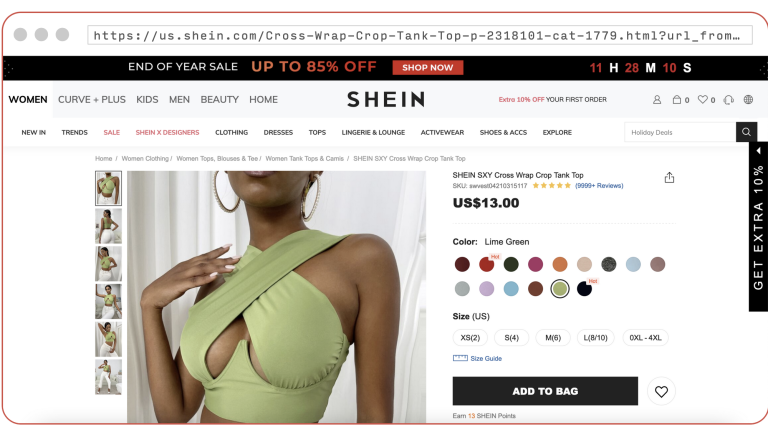
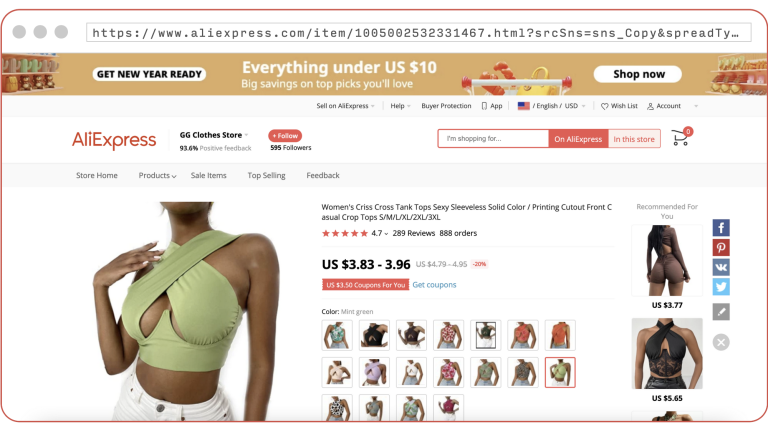
0 Response to "Rest and Relaxation Pants Fashion Report"
Post a Comment